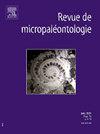日本中部佐渡岛Guadalupian-Lopingian(中晚二叠世)碎屑岩放射虫及介入性凝灰岩和凝灰质砂岩锆石U-Pb年龄
IF 1
Q4 PALEONTOLOGY
引用次数: 0
摘要
研究了日本中部佐渡岛佐渡山太田地区的二叠纪地层,并根据放射虫生物地层学和锆石U-Pb定年确定了其沉积时代。我们还重点研究了该地区的地质及其与日本西南内带其他地质单元的岩性对比。放射虫分析表明,在太田海岸线暴露的泥岩中发现了卵泡虫(Follicucullus porrectus)和扩张虫(F. dilatatus),表明其发育于capitian中晚期至长兴期早期。太田区林道沿线暴露的泥岩中含有卡瑞佛沙维提,表明其时代为凯都世晚期-长兴世早期。对含滤泡泥岩中嵌套的凝灰岩层进行锆石U-Pb定年,加权平均年龄为259.9±2.0 Ma,对应于capitian - wuchiapingian时代。含C. charveti的凝灰质砂岩与泥岩互层的加权平均年龄为264.1±6.3 Ma,涵盖了路甸期至五家坪期。最小模型峰值年龄(256.6±2.6 Ma);五家坪期)提供了最可靠的最大沉积年龄估计。根据化石分布,以前已将Kosado Hills的古生代地层与日本西南部的Ultra-Tamba和Maizuru带进行了对比。研究结果表明,科萨多山二叠系岩石在岩性上与超坦巴带有所不同,但与迈祖鲁带上瓜达鲁普—洛平系有相似之处。本文章由计算机程序翻译,如有差异,请以英文原文为准。
Guadalupian–Lopingian (Middle–Late Permian) radiolarians from clastic rocks and zircon U–Pb ages of intercalated tuff and tuffaceous sandstone on Sado Island, central Japan
We investigated Permian strata in the Ota area of the Kosado Hills, Sado Island, central Japan, and their depositional ages were determined based on radiolarian biostratigraphy and zircon U–Pb dating. We also focused on the geology of the region and its lithologic correlation with other geological units in the Inner Zone of Southwest Japan. The radiolarian analysis identified the presence of Follicucullus porrectus and F. dilatatus in mudstone exposed on the coastline of Ota, indicating a middle–late Capitanian to early Changhsingian age. Mudstone exposed along the forest road in the Ota area contained Cariver charveti, suggesting a late Capitanian–early Changhsingian age. Zircon U–Pb dating of the tuff layer intercalated within the Follicucullus-bearing mudstone yielded a weighted-mean age of 259.9 ± 2.0 Ma, corresponding to a Capitanian–Wuchiapingian age. The tuffaceous sandstone interbedded with mudstone containing C. charveti yielded a weighted-mean age of 264.1 ± 6.3 Ma, which covers the Roadian to Wuchiapingian ages. The youngest model peak age (256.6 ± 2.6 Ma; Wuchiapingian) provides the most reliable estimate of the maximum depositional age. The Paleozoic strata in the Kosado Hills have previously been correlated with the Ultra-Tamba and Maizuru belts in Southwest Japan based on fossil occurrences. Our findings indicate that the Permian rocks in the Kosado Hills exhibit differences in lithology from those in the Ultra-Tamba belt but share similarities with the upper Guadalupian–Lopingian strata in the Maizuru belt.
求助全文
通过发布文献求助,成功后即可免费获取论文全文。
去求助
来源期刊

REVUE DE MICROPALEONTOLOGIE
PALEONTOLOGY-
CiteScore
2.50
自引率
0.00%
发文量
17
期刊介绍:
La Revue de micropaléontologie publie 4 fois par an des articles de intérêt international, consacrés à tous les aspects de la micropaléontologie. Les textes, en anglais ou en français, sont des articles originaux, des résultats de recherche, des synthèses et mises au point, des comptes rendus de réunions scientifiques et des analyses de ouvrages. La revue se veut résolument ouverte à tous les aspects de la micropaléontologie en accueillant des travaux traitant de la systématique des microfossiles (et de leurs équivalents actuels), des bactéries aux microrestes de vertébrés, et de toutes leurs applications en sciences biologiques et géologiques.
 求助内容:
求助内容: 应助结果提醒方式:
应助结果提醒方式:


